WOOD FLOORING HAS COME A LONG WAY SINCE THE 1600s, WITH ITS SOLID WOOD AND STANDARD SPECIES. SO WE ASKED A FEW LOCAL EXPERTS TO FILL US IN ON TODAY’S TRENDS FROM PLANK WIDTHS TO PATTERNS—AND THEY ALL HAVE SOMETHING TO SAY ABOUT POLYURETHANE.
WORDS: AMY PHARE
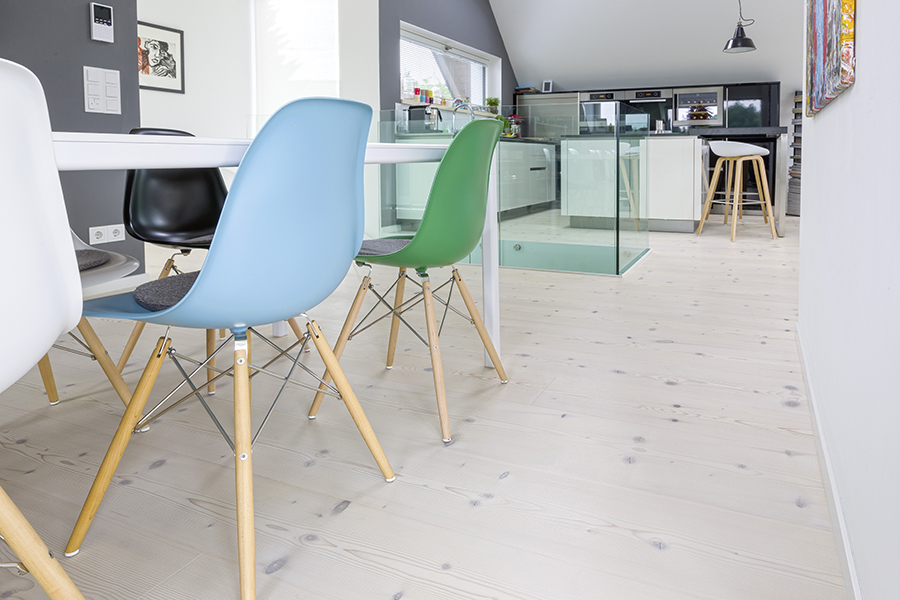 PAY attention the next time you walk across a hardwood floor. Does it feel like a basketball court? Unnatural to the touch? Now pay a visit to the Studio 2b showroom. When Allen Bales invites you to walk barefoot across the Mafi floors, you’ll feel the difference. You’ll feel wood.
PAY attention the next time you walk across a hardwood floor. Does it feel like a basketball court? Unnatural to the touch? Now pay a visit to the Studio 2b showroom. When Allen Bales invites you to walk barefoot across the Mafi floors, you’ll feel the difference. You’ll feel wood.
That sensation is achieved from the European approach of using oil and wax, instead of the all-too-common application of layer upon layer of chemicals like polyurethane. “The beauty of hardwood flooring is feeling the grain of wood,” said Porcelanosa’s Antonio Romero. And that’s just one of the many differences between off-the-shelf wood flooring and the customizable options offered by high-end local retailers.
To learn more, we caught up with a few wood flooring aficionados, who have years of industry know-how from showroom samples to installation and finishing. And it’s worth the listen, as wood flooring is “your biggest piece of furniture, the biggest investment you see every day,” according to Doug Townsend of Arrigoni Woods in RiNo. From species to colors to curves, whether you’re outfitting your floors for the first time or are in search of the latest looks, here are six considerations from the pros.
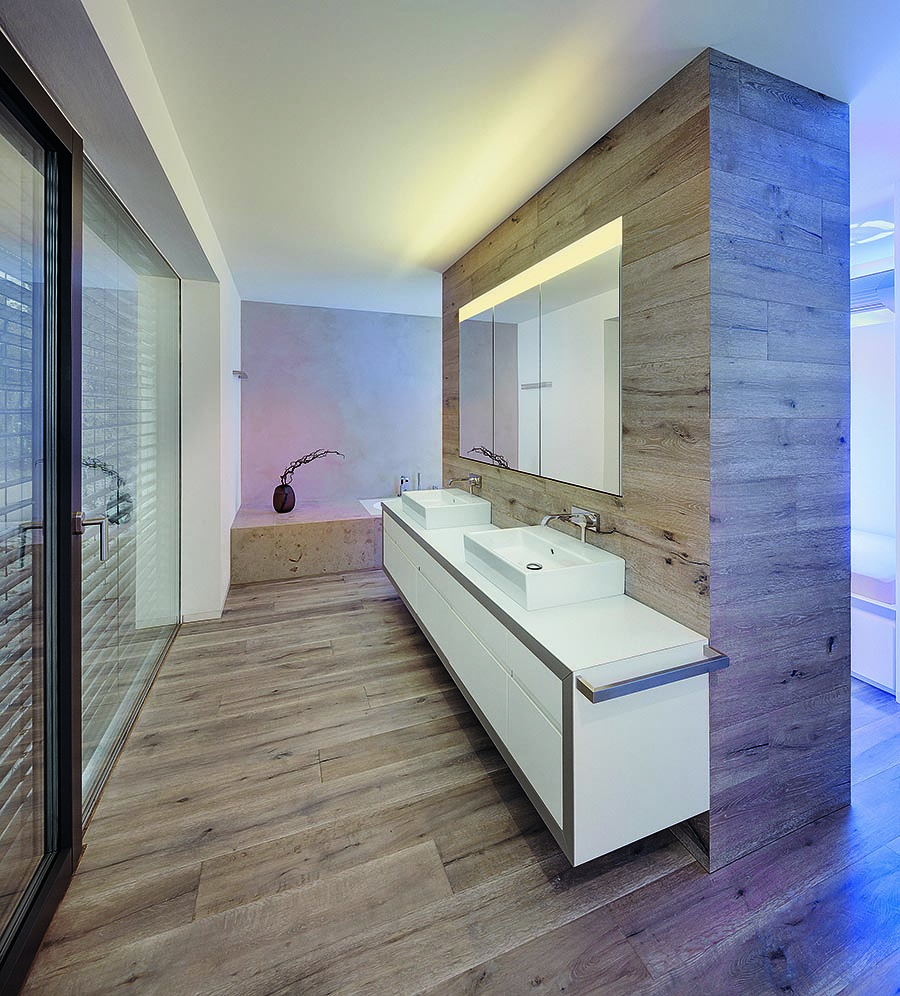
SELECTING A SPECIES
Wood flooring dates back centuries and is still the material of choice for modern homes—but a lot has changed since Colonial times. Upon entering a showroom, one of the first questions asked will likely pertain to your wood of choice—or what that boils down to is what look you’re trying to achieve, along with hardness (check the Janka scale), grain pattern, ability to add color, the room and use, and of course, your budget.
If opting for a traditional species, light woods like ash or maple will make your space feel open and airy. Medium woods like oak will make the space warm, and darker selections like mahogany, which are much richer, are best kept for a library. “Most of your square footage is in your floors, so it can make or break a room whether rustic or contemporary,” said Brian Bradley, owner of Vantia Hardwoods. And while traditional walnut, cherry, and maple still dominate the market, species have expanded to now include reclaimed wood, eucalyptus, bamboo, and even exotics like Tigerwood. “There is still a market for traditional species, but it’s different now,” said Romero. The difference is in the details. With exotics, you’ll see more unique grain patterns, and with Porcelanosa’s specialization in European white oak, you can achieve more custom colors because of its ease in staining. And when it comes to colors, that’s where the trends are.
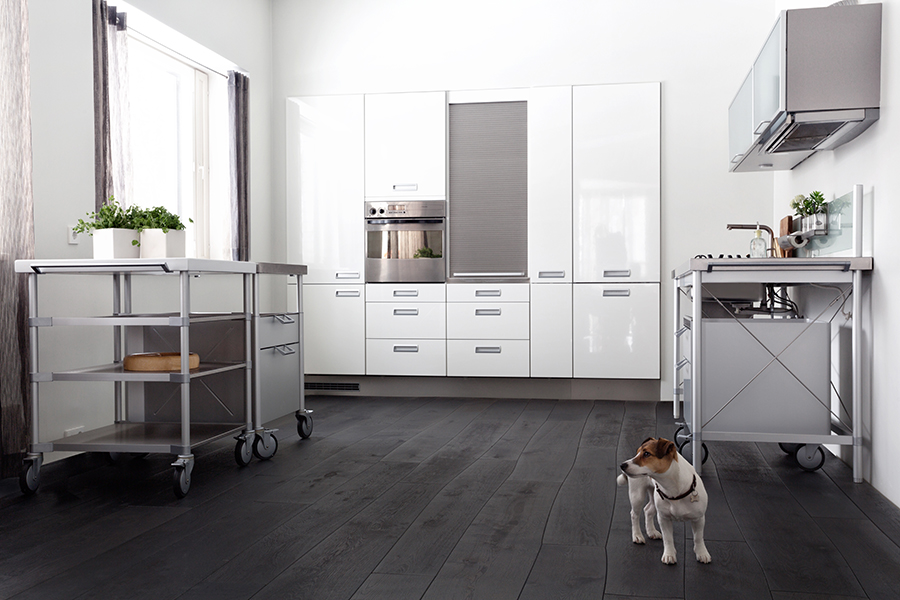 THE COLOR WHEEL
THE COLOR WHEEL
This season, flooring colors are all about the grays, blacks, and whites, and, of course, traditional browns are always timeless. The beauty of venturing beyond the big box store though is that color options are limitless. “Over the years, we’ve come to realize what people are looking for and create our own colors. We look at images and create the perfect color for that particular project,” said Townsend, who imports his four lines of wood flooring all from Europe.
Not only are there endless colors, but there are also many ways to achieve those colors. Mafi’s Vulcano heat treatment process uses only heat, wind, and water—no chemicals. During this process, the wood is caramelized and darkens through the full thickness of the wood versus stain, which just sits on top.
While a traditional off-the-shelf product may offer limited color options, it’s clear that one of the biggest perks of avoiding that route is the customization. “The freedom in this collection is the most valued thing,” said Romero about Porcelanosa’s own wood flooring product and the L’Antic Colonial line they carry. Their coloring method also shies away from chemicals by way of sunflower oil and carnauba wax. “It makes for a natural product and allows us to use a wide range of colors made naturally,” he said.
For those with modern mountain homes, the Mafi line can also be found at Vantia in Frisco. “Our installers and finishers have 20+ years of experience, and they are masters of what they do,” said Bradley. “The finishers are truly artists who come up with stains you don’t see anywhere else. We come up with colors unique to their houses for people looking for a very specific color. We have endless colors, whatever you can dream up.”
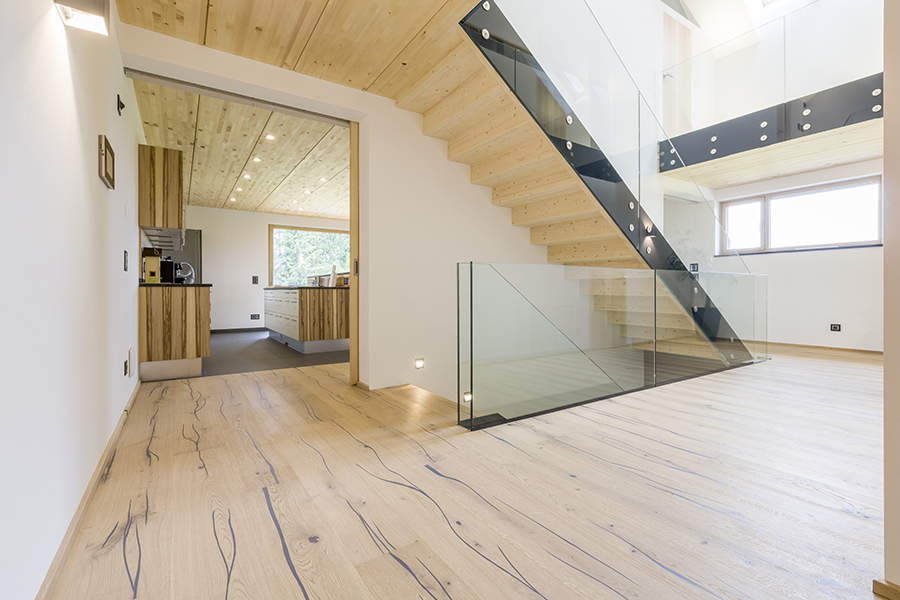
PICKING A PATTERN
At Vantia, they also offer one of the latest trends: curved-length flooring. Instead of typical straight cuts, Bolefloor offers lengths that curve to follow a tree’s natural growth. While this method has existed in Europe for years, it is new to the U.S. And not only is it unique, beautiful, and natural looking, but the method is also eco-friendly. “There is a lot of waste with traditional straightening work,” Bradley explained. “With this method, you use the tree in its entirety.”
Adding to the design mix is Mafi’s Carved Timber line, used not just on floors, but on walls and even furniture. Its carving technology engraves designs, and some are enhanced with the Vulcano thermal heat treatment. “There’s nothing else out there like it,” said Bales. “It’s highly unique and has so much character. But beyond the character and their ‘Walk on Art’ philosophy, it’s an engineered floor.” And with that, we move beneath the surface to the floor’s structure.
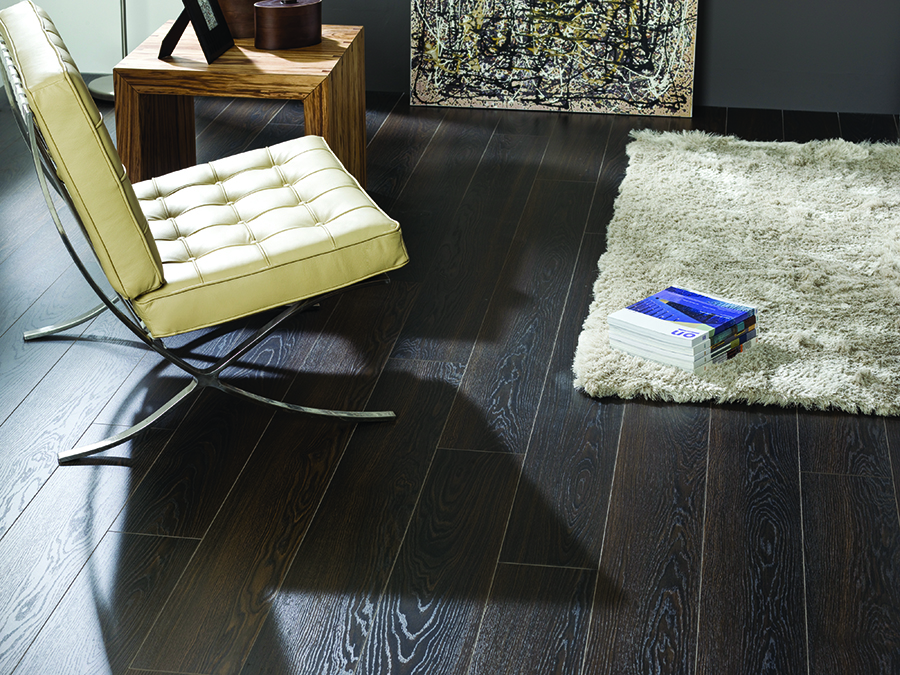 SOLID OR ENGINEERED?
SOLID OR ENGINEERED?
Bales is a proponent of engineered floors, as were all of our expert interviewees, but there has been some misconception over the years about them.
Engineered wood floors are not artificial! In fact, they are real wood floors, but they are manufactured using multiple layers. So what’s the benefit? “It’s extremely stable,” said Bales. “You won’t get that at a big box store.” With each layer running perpendicular to the one below, engineered floors offer greater stability and are less likely to expand and contract than solid wood flooring. “It behaves much better and reacts less with changes in humidity,” said Romero.
While solid wood flooring is unable to be used below grade and presents problems with moisture, it is still an option for those who prefer the traditional route and are interested in repeated sanding and refinishing. “People should know that there are options—that there are high-quality, engineered products that are more stable than solid floors,” said Bradley. “Everything else is equal; you can get different lengths, finishes, and the wear layer is the same.”
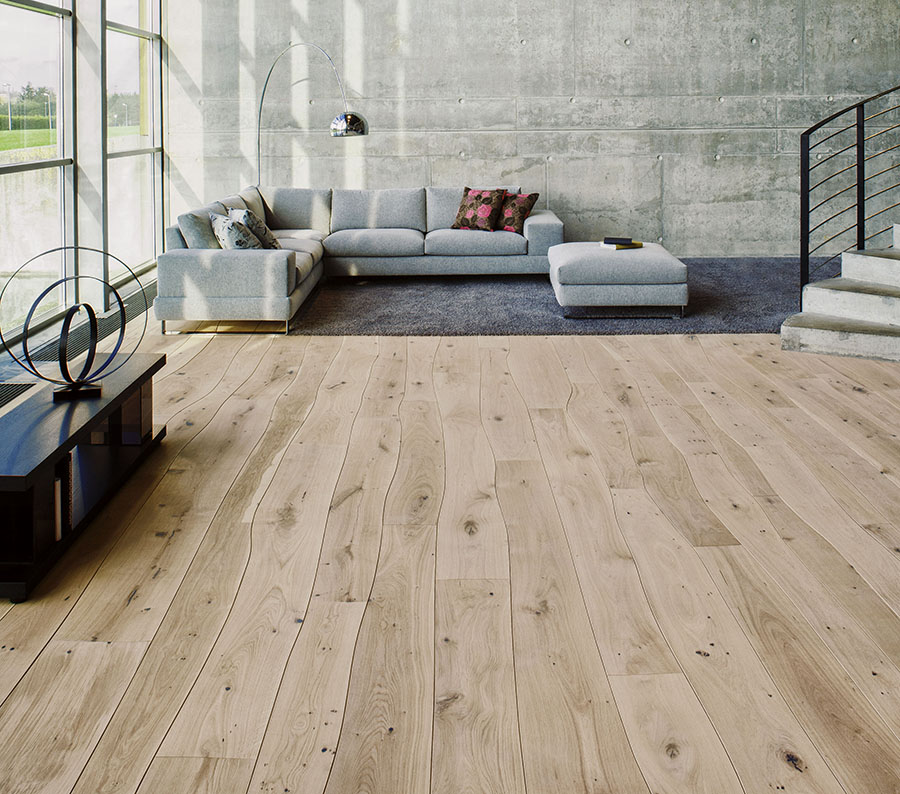
CUT IT OUT
As if there weren’t already infinite options, one thing you’ll need to take into consideration is size. Trending are wider widths and longer planks, which visually open a small space. “In using longer lengths, it makes a statement,” said Townsend. “It’s a much more contemporary look.” And that’s yet another advantage of specialty shops. They go to great lengths—some up to 16 feet, in fact, providing an expansive feel and fewer joints.
When it comes to width, 5+ inches is becoming the norm all the way up to 16 inches. “It’s a cleaner look. It feels more natural,” said Bales. “Trees are naturally wider, so narrow planks don’t feel natural.”
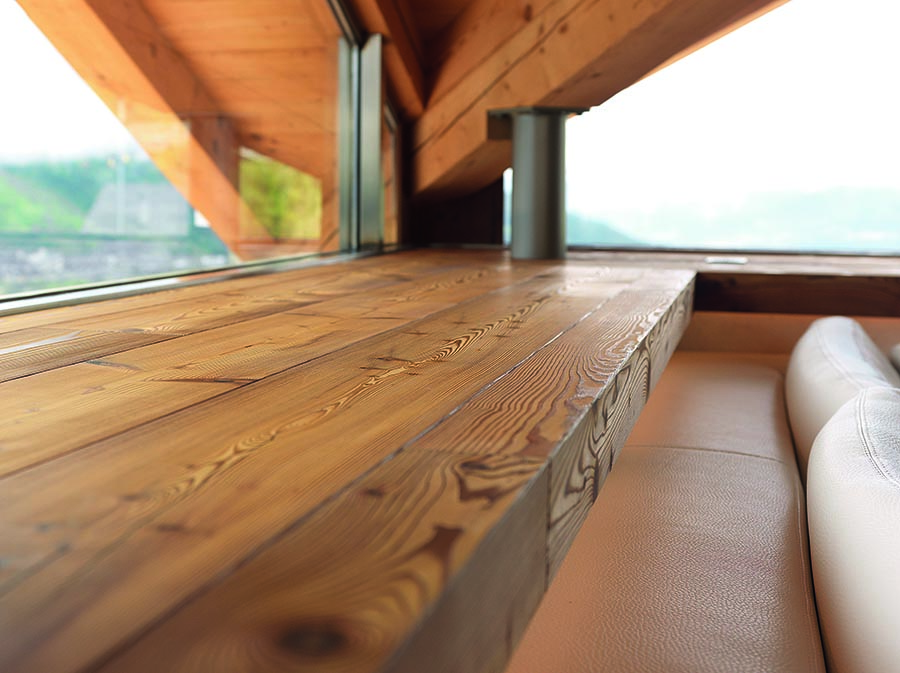
FINISHING
Last, but certainly not least, is the finishing. There are two main routes here: unfinished flooring, which the installer will sand and finish onsite, or factory-finished wood flooring, which is pre-finished by the manufacturer. “Have it finished onsite if you want a smooth, flat floor,” said Bradley. But if time is of the essence, go with the finished option, as you’ll be able to walk on the flooring soon after the installation.
Whether finished onsite or afar, there are other finishing options to consider. For example you can get a textured finish with options from carving to wire brushing to hand-scraping. “If somebody wants a brushed surface, they will feel it,” said Bradley. “If it’s hand-scraped, you’ll feel it. You smell the wood, when you clean it.” It’s a full sensory experience, and visually, you can even opt for a beveled edge, “which adds depth to a floor—not like a basketball court,” said Bradley.
Then there’s the finish itself. Many simply take into consideration the level of sheen desired, but there’s more to it than the final look. The colors offered by Porcelanosa’s oil and wax method above serve double duty; they penetrate the wood opposed to painting the surface, making “the natural finish feel like real wood,” said Romero.
A common misconception is that the oil and wax finish without layers of varnish will be more likely to show spills, but that thinking is quite contrary to the truth. “Wood is a living, breathing thing,” said Bradley. “If unfinished, it can expand back, breathe, and react how wood is supposed to react.” Both Bradley and Bales shared stories of massive floods, where the homeowners’ natural floors were the only items to survive. Because of the finish, the water did not get trapped and was able to evaporate. The product responds similarly when dented. After a few mops on a heavily dented floor, it will react like a sponge, expanding to its initial form.
While the world of finishes is vast and includes water-based finishes, a variety of lacquers, a Swedish finish method, and UV hardening oils, one thing our experts stand (strongly) together against is poly. “It’s taking wood and turning it into plastic,” said Bradley. “It’s toxic, offgassing, and harder to maintain. There are so many terrible things about it.” Your best bet, according to him: “Bring nature in, and allow it to be living. It makes people happier than plastic floors.”
To read the full story, click to view the PDF from the winter issue of Modern In Denver.




